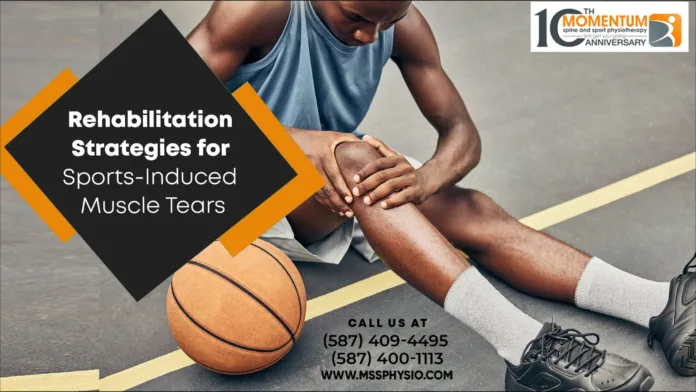Muscle tears are a common setback for athletes, often resulting from intense physical activity and sports-related incidents. Effective rehabilitation is important for a full recovery and return to peak performance. Sports injury physiotherapy offers tailored strategies to address these injuries, promoting healing and preventing future occurrences. For those seeking expert care, sports physiotherapy in Edmonton provides specialized treatment plans designed to meet the unique needs of athletes, ensuring a safe and efficient recovery process.
1. Cryotherapy and Thermotherapy
Cryotherapy: In the initial phase of a muscle tear, applying ice packs helps reduce inflammation and pain by constricting blood vessels. This method is crucial in managing the acute symptoms of a muscle tear, as it limits the extent of swelling and numbs the affected area, providing immediate relief.
Thermotherapy: As healing progresses, heat therapy is introduced to relax muscles, improve blood flow, and facilitate tissue repair. Heat applications, such as warm packs or heating pads, help loosen tight muscles, enhance flexibility, and promote the delivery of oxygen and nutrients necessary for healing.
2. Manual Therapy
Massage: Therapeutic massage techniques help reduce muscle tightness, improve circulation, and break down scar tissue. By manipulating the soft tissues, massage therapy enhances blood flow to the injured area, minimizes muscle spasms, and aids in removing metabolic waste products, which speeds up recovery.
Soft Tissue Mobilization: This involves techniques like myofascial release and trigger point therapy to aim at certain regions to alleviate pain and improve muscle function. These methods involve applying controlled pressure to the connective tissues and muscles to release tension, improve mobility, and effectively address localized pain points.
3. Electrotherapy
Transcutaneous Electrical Nerve Stimulation: Using electrical currents to manage pain and promote muscle relaxation. TENS therapy helps block pain signals to the brain, reduce muscle spasms, and increase endorphin production, which are natural pain relievers.
Neuromuscular Electrical Stimulation: NMES therapy involves sending electrical impulses to the muscles, making them to contract and relax. This stimulation helps maintain muscle tone, prevent atrophy, and enhance muscle strength and function recovery during rehabilitation.
4. Stretching and Flexibility Exercises
Static Stretching: Holding stretches for a prolonged period to improve muscle length and flexibility. An example of static stretching is the hamstring stretch, where one sits with legs extended, reaches forward, and holds the position for 30 seconds. This helps lengthen the hamstring muscles, improve flexibility, and reduce muscle stiffness.
Dynamic Stretching: Leg swings are a common dynamic stretch in which one swings the leg forward and backward to loosen up the hip flexors and hamstrings before exercise. This type of stretching increases blood flow warms up the muscles, and improves the range of motion, making it ideal before engaging in sports or physical activities.
5. Strengthening Exercises
Isometric Exercises: Strengthening muscles without joint movement, ideal for the early stages of recovery. An example is the plank, where one holds a push-up position, engaging the core muscles without moving the joints. This builds muscle strength and endurance while minimizing stress on the injury, making it a effective way to maintain muscle mass during the initial recovery phase.
Progressive Resistance Training: Gradually increasing resistance through weights or resistance bands to rebuild muscle strength. An example is bicep curls with resistance bands, starting with light resistance and gradually increasing as strength improves. This method helps restore muscle power and functionality, ensuring a steady and controlled increase in strength as the body heals.
6. Range of Motion (ROM) Exercises
Active ROM Exercises: The patient performed movements to maintain joint flexibility and muscle mobility. Shoulder circles, where one rotates the shoulders in a circular motion, are a simple active ROM exercise that helps maintain shoulder flexibility. These exercises are crucial for preventing stiffness and keeping the joints and muscles flexible and functional.
Passive ROM Exercises: Movements performed by the therapist to help maintain flexibility without muscle effort. For example, during a passive knee bend, the therapist gently bends and straightens the patient’s knee to maintain joint mobility without active muscle engagement. This technique is particularly useful when patients cannot perform movements independently due to pain or weakness.
7. Proprioceptive Training
Balance Exercises: Using balance boards or balls to improve joint stability and proprioception. Standing on a balance board while performing slight weight shifts enhances ankle stability and proprioceptive awareness. These exercises help enhance the body’s ability to sense its position in space, essential for preventing falls and maintaining stability during dynamic movements.
Coordination Drills: Exercises that enhance neuromuscular control and coordination are crucial for athletes returning to sports. Ladder drills are where one steps in and out of a ladder placed on the ground improve footwork and coordination. These drills are designed to sharpen the body’s ability to perform precise and controlled movements, vital for peak athletic performance.
8. Functional and Sport-Specific Training
Sport-Specific Drills: Exercises that mimic the movements and demands of the athlete’s sport to ensure a safe return to activity. For example, a soccer player might practice dribbling and shooting drills to regain specific skills and confidence on the field. These drills help bridge the gap between general rehabilitation and the exact physical demands of the sport.
Functional Training: Incorporating exercises that simulate daily activities to ensure overall functional recovery. Squats are a common functional exercise that mimics the movement of sitting and standing, helping to improve strength and stability for everyday tasks.
Sports physiotherapy in Edmonton utilizes these techniques to provide comprehensive care for muscle tears.
Start the Recovery Journey with Sports Physiotherapy
Rehabilitation strategies for sports-induced muscle tears are essential for athletes looking to recover quickly. Momentum Physiotherapy offers comprehensive care through sports physiotherapy in Edmonton, providing tailored treatment plans to address individual needs.
Finding a sports physio near me is crucial for those searching for effective treatment options. Contact Momentum Physiotherapy today to learn how our experienced team can help you get back to your best. Don’t let a muscle tear keep you sidelined—start your recovery journey with the right support and guidance.
